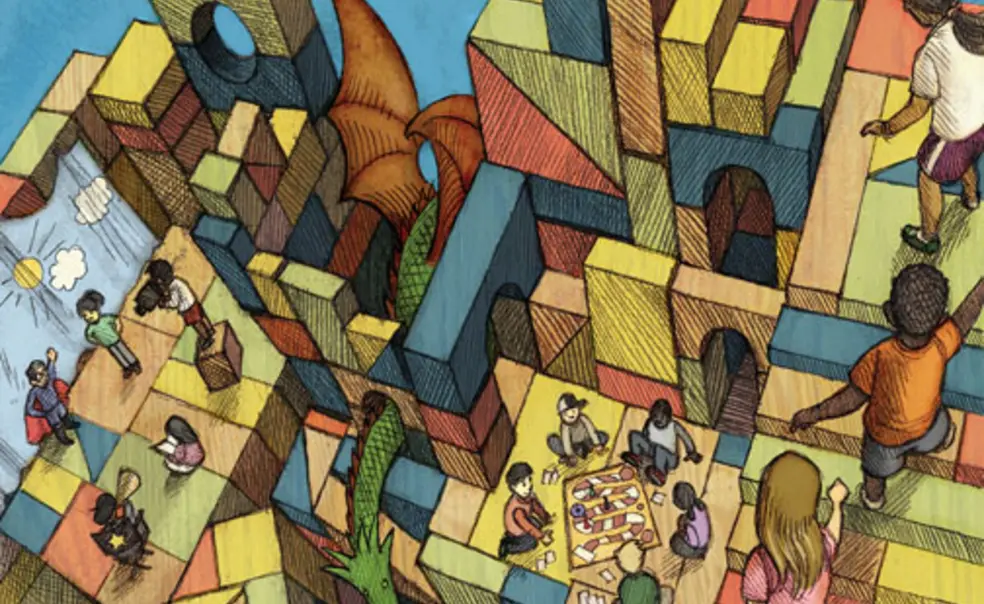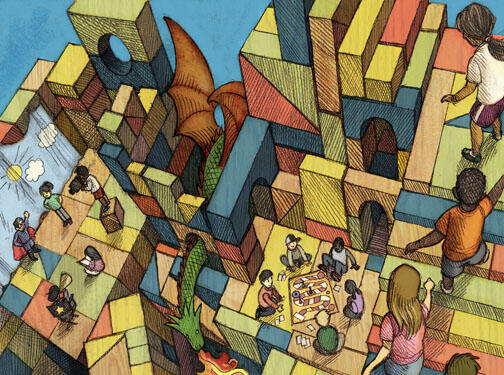Janet Lee ’06 earned her master’s degree in early childhood education from Bank Street College in New York. She teaches kindergarten in Los Angeles.
The main thing I learned in my first year of teaching was how to get 25 kindergartners to walk in quiet, parallel lines.
As an assistant teacher in a Lower Manhattan charter school, I had to supervise the uniformed 5-year-olds as they moved from class to class. The small school occupied the top floor of a large public-school building, and we had to trek up and down five flights of stairs at least twice a day, not including trips to the gymnasium and other classrooms. The school’s behavior policies dictated that children walk side by side, each quietly holding a partner’s hand and looking straight ahead. If you’ve ever spent time moving small children from one place to another, you know that this was a tall order.
On the first morning of kindergarten, the lead teacher and I began the arduous task of teaching hallway behavior. For the rest of the year, I sent kids who chatted or giggled to the rear of the line and told children who skipped a step to go back up the stairs to try again. I even reprimanded those who dared to admire the bulletin boards for not looking where they were going. Many tears (theirs) and much sweat (mine) ensued, but we did it. My class walked obediently.
There was one problem, however. By the time the kids reached their classroom, they were exhausted from holding in their impulses and energy. Learning — the real work — was supposed to begin, but the kids barely could contain themselves to attend to the lesson.
As a young teacher working in a low-income neighborhood, I thought to myself: “I graduated from Princeton. I can change the lives of 25 kindergartners.” I was going to fill their hungry, deprived minds with nourishing knowledge gleaned from my Ivy League experience. I was going to make them behave and absorb information. All the kids had to do was demonstrate mastery of their learning. It was simple: I would conduct assessments, both oral and written; their scores would climb; and the lines on my achievement graphs would soar.
But then I gained some perspective. The main thing I learned in my second year of teaching was that children are stifled by quiet lines.
During the day, I was insisting that kids comply with strict rules and squeezing in as many hours of academic instruction as possible. At night, I was learning to do the opposite, as a student at Bank Street College. Bank Street adheres to a child-centered, developmentally appropriate, progressive educational philosophy. My professors espoused John Dewey’s beliefs that children thrive when they interact with their curriculum and take a lead role in their own learning. The teacher’s responsibility is not to imbue children’s minds with a finite set of skills while they sit passively, but to provide compelling learning opportunities where kids engage actively with materials and with one another.
Pressured by demands of testing and curriculum coverage, I wasn’t providing occasions for exploratory learning or teachable moments. My kindergartners read like first- and second-graders, but they could not work or play cooperatively. Instead of mulling over complicated word problems, my kids wanted quick answers. They had the visual tracking skills to fill in the bubbles on tests, but lacked the capacity to think critically and confront real-life challenges. The fact that they were largely from low-income communities exacerbated my moral struggle. The achievement-oriented programs of so many inner-city charter schools, like mine, seemed solely focused on increasing test scores, while neglecting children’s individuality, interests, and voices. Shouldn’t I be empowering these kids to think and advocate for themselves? Instead of teaching them to meet top-down expectations, shouldn’t I be encouraging them to become self-starters, so they would not be afraid to challenge the establishment?
The main thing I learned in my third year was how to get through the halls halfway respectably so that we could begin the real learning in the classroom. That year, promoted from assistant to lead teacher, I introduced as many progressive practices as I could, convincing my fellow kindergarten teachers to set up dramatic play and block-building. Instruction, though, still followed the school’s demanding curriculum. The kids had to reach certain benchmarks in reading and math, and we worked hard to prepare them for tests. Meanwhile, there seemed to be a rise in the number of smiles that year, from children, parents, and myself.
In my fourth year of teaching, I abandoned straight lines. I moved to Los Angeles and took a job teaching kindergarten at an independent school. Public schools had a hiring freeze, and I wanted to look beyond the academics-centered charters to gain experience in a school more aligned with Bank Street’s philosophy. Though I respect the teachers at my old school for supporting the underserved population in the best way they know how, my experiences have led me to believe differently. I wanted to work in a setting that fostered creativity and the joy of learning.
For the past two years, I have been able to experience that joy alongside the children I teach. In my classroom, I have witnessed incredible displays of academic and social intelligence as children partake in creative play and learning opportunities. A group of kids build water filtration plants, film studios, and intricate mazes out of wooden blocks. One time, a student compared a story about a dragon ostracized by nearby villagers to the experience of African-Americans in our country during the time of Martin Luther King Jr. Some of my 5- and 6-year-olds can compute mathematical calculations with three- or four-digit numbers. Others insist upon playing in teams a board game meant for individual players, so they can cheer for each other. Each child is comfortable asserting his or her ideas. When kids have time and space to work collaboratively and make choices, they are more able to make intellectual connections, to relate to one another, and to take pleasure in their learning. Children have a sixth sense. They know when an adult genuinely shares their interest, and the benefit of that collective learning far exceeds test results and benchmarks.














No responses yet